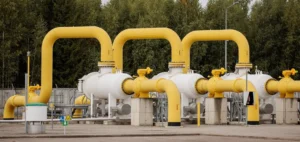Global demand for liquefied natural gas (LNG) is set to grow significantly over the next two decades, with an estimated 60% increase by 2040. According to Shell’s LNG Outlook 2025, this expansion will be largely driven by economic growth in Asia, the energy transition in industry and transport, and the increasing role of artificial intelligence (AI) in energy network optimisation. Revised projections indicate that LNG consumption could reach between 630 and 718 million tonnes per year by 2040, exceeding previous forecasts.
Strong demand driven by China and India
Asian economies are playing a central role in the LNG boom, particularly China and India, which are heavily investing in expanding their gas infrastructure. China plans to increase its LNG import capacity and expand its gas pipeline networks to reach 150 million people by 2030. Meanwhile, India continues its natural gas development, aiming to add connections for 30 million households over the next five years.
Growing adoption in the maritime transport sector
The maritime sector is also a key driver of LNG growth. Orders for LNG-powered vessels are increasing, with demand expected to exceed 16 million tonnes per year by 2030, a 60% rise compared to previous forecasts. LNG is becoming a strategic fuel for shipping and road transport due to its cost-effectiveness and emissions reduction benefits. It also paves the way for the integration of alternative fuels such as bio-LNG and synthetic LNG.
The United States and Qatar leading exports
LNG production will be dominated by two major players: the United States and Qatar. The United States is set to strengthen its position as the world’s leading LNG exporter, with volumes potentially reaching 180 million tonnes per year by 2030, accounting for nearly a third of global supply. However, uncertainty remains regarding the timeline for new projects, which could impact supply capacity.
Market tensions and price volatility
In 2024, global LNG trade experienced moderate growth, with an increase of just 2 million tonnes—the lowest in a decade—due to slowed supply development. After falling to their lowest levels since early 2022, LNG prices rebounded mid-year as delays in new projects impacted availability.
In Europe, LNG imports declined by 19%, or 23 million tonnes, due to increased renewable energy generation and limited industrial demand recovery. However, towards the end of the year, colder winter temperatures and intermittent wind power generation drove strong demand for gas storage. The expiration of Russian pipeline gas deliveries to Europe via Ukraine on 31 December 2024 further contributed to rising gas prices. Europe is expected to increase LNG imports in 2025 to replenish its gas reserves.






















